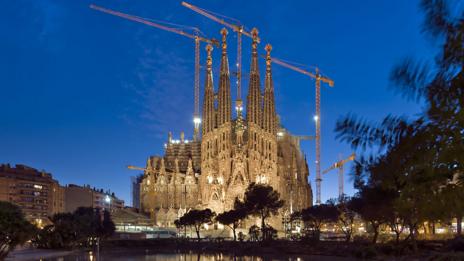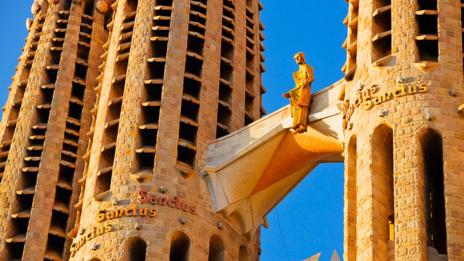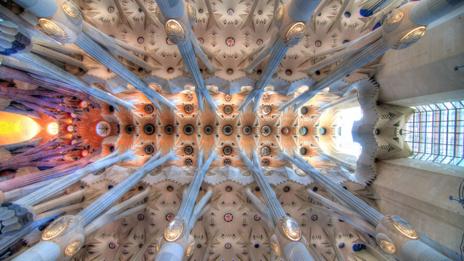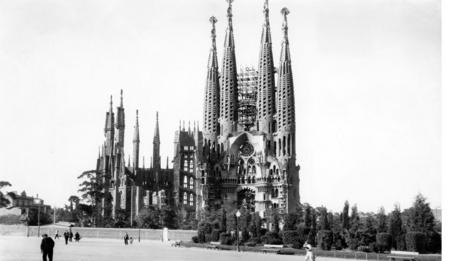【你所不知道的西班牙 ~ 高第的拼花地磚】
前面兩則 po 文從水泥彩磚(Baldosas hidráulicas)講到巴塞隆納的高第的地磚。
前面兩則 po 文從水泥彩磚(Baldosas hidráulicas)講到巴塞隆納的高第的地磚。
看過高第的地磚的人都覺得它很美,不過,很少人知道,這個地磚是拼花的,地磚只有一個花案,但是拼起來總共有三個花紋,所以,工廠只要做一個地磚,工人卻要玩拼圖,不能拼錯!
⋯⋯更多Drawing by the Spanish Catalan architect Antoni Gaudi. {Only atFULCRUM: an annual of poetry and aesthetics.}

Jonathan Glancey

(Getty)
Soaring above Barcelona, Antonio Gaudí’s church will eventually become the world’s tallest when it is finally finished. But is it also the most controversial religious building? Jonathan Glancey investigates.
“My client is in no hurry”. Antoni Gaudí believed that God had all the time in the world, so there was no need to rush the completion of the Catalan architect’s most ambitious work, the Sagrada Família. Often mistaken for Barcelona’s cathedral, the breathtaking Basilica and Expiatory Temple of the Holy Family, paid for entirely by private donations and sales of tickets to the 2.5 million people who visit it each year, is unlikely to be finished before 2026. Given that construction began in 1882, this is clearly the work not just of a singular and devoutly religious architect, but of several determined generations of dedicated professionals and enthusiasts.
When the final stone is set in place, the Sagrada Família will be the world’s tallest church, soaring 560-ft (170-m) above the Catalan capital. It will also be the strangest looking and possibly the most controversial place of worship ever built on such an epic scale. Looking for all the world like a cluster of gigantic stone termites’ nest, a colossal vegetable patch, a gingerbread house baked by the wickedest witch of all or perhaps a petrified forest, this hugely ambitious church has confounded architects, critics and historians ever since its unprecedented shape became apparent soon after World War I.
George Orwell said it was “one of the most hideous buildings in the world” and rather hoped it would be destroyed during the Spanish Civil War. Salvador Dalí spoke of its “terrifying and edible beauty”, saying it should be kept under a glass dome. Walter Gropius, master of right-angled architecture and founder of the Bauhaus, praised its technical perfection. Louis Sullivan, the great American architect, and “father of skyscrapers”, described it as “spirit symbolised in stone.”

Gaudi developed a radical architecture that was before its time (Getty)
Tourist trap?
When the mind-numbingly complex stone vault over the 150-ft (45.7-m) high nave was completed in 2010 and the basilica consecrated by Pope Benedict XVI, the debate reignited. According to Manuel Vicent, a columnist for the Madrid daily El Pais, “The only saving grace of the Temple of the Sagrada Família was the fact that it was unfinished, the dream of a genius driven crazy by mystic reveries. Now it will completed with the money of tourism, and when its walls are finally enclosed, there will be no one inside but Japanese tourists.”
The architect Enric Massip, a member of the Advisory Committee to the City of Barcelona, denounced the basilica as “an artificially inflated space lacking in soul.”

George Orwell called the Sagrada Familia 'one of the most hideous buildings in the world' (Getty)
Intriguingly, Massip founded his own architectural studio in 1990 “with the goal to create a leading and innovative practice at the edge of architectural thinking”. Without spelling it out – he rarely wrote thoughts down, and drew precious little – this is very much what Antoni Gaudí had done when he developed a form of radical architecture that, in many ways, was far ahead of its time.
Those who take against the Sagrada Família do so largely because they refuse to see beyond its richly decorated and apparently arbitrary forms. Scratch the surface, though, and this mind-bending building proves to be a tour-de-force of highly sophisticated mathematics and advanced structural engineering. Gaudí based his designs on the complex forms we know today (or ought to know) as helicoids, hyperboloids and hyperbolic paraboloids. These are forms abstracted from nature and then translated into the design of the columns, vaults and intersecting geometric elements of the structure of the Sagrada Família. Look up at the vault crowning the interior of the basilica’s nave. Does this resemble a dense forest of trees with sunlight shining through it? Gaudí hoped you might see it like this. Everything he designed, he said, “comes from the Great Book of Nature”. His ‘textbooks’ were the mountains and caves he loved to explore.

Gaudi based his forms on complex designs abstracted from nature (Getty)
In fact when Mark Burry, a 23-year-old New Zealander came to Barcelona in 1980, and became involved in trying to piece the fragments of Gaudí’s remaining architectural models of the Sagrada Família together, he was unable to make sense of their unfamiliar and demanding geometry until the peseta dropped and he understood that it was in the rock formations of mountains, among other natural phenomena, that Gaudí’s exceptional mathematical imagination had been rooted.
Burry went on to become both the executive architect of the Sagrada Família and a leading light in spatial design and computer programming at RMIT University, Melbourne. Devising parametric computer modelling techniques, adapted from the aerospace industry, Burry has been able to complete Gaudí’s designs. Working under Jordi Faulí I Oller I, director of works in Barcelona, he has even sped up the construction process by having stones cut by computer-driven machinery. What Burry and his associates in Barcelona find so very humbling is that Gaudí was able to work out such complex three-dimensional mathematical models in his mind’s-eye, using intuition alone.
Architectural miracle?
What few models and sketches there were by Gaudí’s hand were mostly destroyed by Catalan anarchists when they assaulted the Sagrada Família during the Spanish Civil War. They did, however, leave the architect’s tomb intact. For, whatever their grudge against General Franco and the Catholic Church, they knew full well that Gaudí was considered a saint by people of all classes and political beliefs. On 7 June 1926 Gaudí had been struck down by a tram at the intersection of Barcelona’s Carrer de Bailén and the Gran Via. Taxi drivers refused to take a man they mistook for a beggar to the city hospital. Local people took the wafer thin and ragged old man to the pauper’s hospital instead. When he was discovered there, Gaudí refused to be moved. “My place is here”, he said. Thousands lined the streets for his funeral.

Construction began in 1882 and will not be completed before 2026 (Hulton Archive/Getty Images)
It is difficult today to understand the upswell of religious feeling that had given rise to the Sagrada Família. The idea had come to Josep Maria Bocabella, a printer of religious books after a visit to Italy where he made a pilgrimage to the Shrine of Loreto, the church housing what is alleged to be the house in which the Archangel Gabriel appeared to the Blessed Virgin Mary. The house had been flown to Italy, it was said, by angels to save it from desecration in the 13th Century. Bocabella founded the Associació de Devots de Sant Josep which bought the land for the Sagrada Família and paid for the work. At its peak, these devotees of St Joseph, Mary’s husband, numbered 600,000. If faith could move mountains, it could build Gaudí’s basilica. The Association for the Beatification of Antoni Gaudí now campaigns for the architect to be made a saint.
When complete, the basilica will boast no fewer than eighteen spires – eight have been built so far 12 representing Christ’s apostles, four the evangelists (Matthew, Mark, Luke and John), one the Blessed Virgin Mary and the tallest, Christ the Saviour.
It may be difficult for puritan eyes, or those with a decided preference for straight lines and minimalist aesthetics to look at, and yet this utterly brilliant feat of imaginative construction has inspired designs by some of the world’s finest engineers and architects over the past century, Oscar Niemeyer, Frei Otto and Pier Luigi Nervi among them. It will continue to haunt the imagination of generations to come for whom its architect may well come to be known, officially, as Saint Antoni Gaudí.


沒有留言:
張貼留言